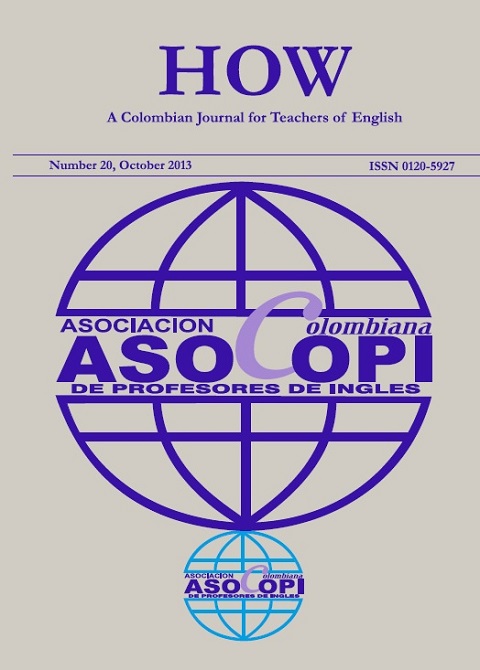Desarrollo de la competencia gramatical en el contexto de la producción escrita
Contenido principal del artículo
Resumen
Detalles del artículo
Los contenidos de la revista HOW se publican bajo la licencia Creative Commons Atribución-NoComercial-SinDerivar 4.0 Internacional. Usted es libre para copiar y redistribuir el material en cualquier medio o formato siempre y cuando usted otorgue el crédito de manera apropiada. Usted no puede hacer uso del material con fines comerciales. Si usted mezcla, transforma o crea nuevo material a partir de esta obra, usted no podrá distribuir el material modificado. Más información: http://creativecommons.org/licenses/by-nc-nd/4.0/deed.es.
Se solicitará a los autores cuyos artículos se aceptan para publicación en HOW que firmen una cesión de derechos no exclusiva con el fin de permitir a ASOCOPI reproducir el texto completo en el internet o en cualquier otro medio disponible. Los autores conservan los derechos sobre sus manuscritos con las siguientes restricciones: el derecho de primera publicación es otorgado a ASOCOPI; los autores pueden establecer acuerdos no exclusivos con terceros siempre y cuando la publicación original en la revista HOW sea reconocida adecuadamente.
Citas
Council of Europe. (2001). Common European framework of reference for languages: Learning, teaching, assessment. New York, NY: Cambridge University Press.
Eskey, D. E. (1983). Meanwhile back in the real world: Accuracy and fluency in second language teaching. TESOL Quarterly, 17(2), 315-323.
Giraldo, M. C., & Perry, R. A. (2008). Treating ESL writing errors: Balancing form and content. HOW A Colombian Journal for Teachers of English, 15, 107-123.
Harmer, J. (2004). How to teach writing. London, UK: Longman.
Hedge, T. (2002). Teaching and learning in the language classroom. Oxford, UK: Oxford University Press.
Hymes, D. (1971). Competence and performance in linguistic theory. In R. Huxley & E. Ingram (Eds.), Language acquisition: Models and methods (pp. 3-28). London, UK: Academic Press.
Jago, D. (2006, May). Re: What is your most compelling reason for teaching grammar? [Letter to the “Teacher to Teacher” section]. The English Journal, 95(5), 18-19.
Mendoza, E. (2005). Implicit and explicit teaching of grammar: An empirical study. PROFILE Issues in Teachers’ Professional Development, 5(1), 7-22.
Nunan, D. (1991). Syllabus design. Oxford, UK: Oxford University Press.
Nunan, D. (1992). Research methods in language learning. London, UK: Cambridge University Press.
Patterson, N. (2006, May). Re: What is your most compelling reason for teaching grammar? [Letter to the “Teacher to Teacher” section]. The English Journal, 95(5), 19-20.
Pienemann, M. (1984). Psychological constraints on the teachability of languages. Studies in Second Language Acquisition, 6(2), 186-214.
Savignon, S. J. (1972). Communicative competence: An experiment in foreign language teaching. Philadelphia, PA: The Centre for Curriculum Development.
Savignon, S. J. (2001). Communicative language teaching for the twenty-first century. In M. Celce-Murcia (Ed.), Teaching English as a second or foreign language (pp. 13-28). Boston, MA: Heinle and Heinle.
Sesnan, B. (2001). How to teach English. Oxford, UK: Oxford University Press.
Thornbury, S. (1999). How to teach grammar. London, UK: Pearson Education.
Yan, G. (2005). A process genre model for teaching writing. English Teaching Forum, 43(3), 18-26.

